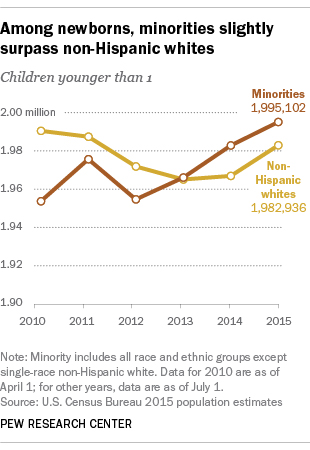White Births Are a Us Majority Again

The U.S. is projected to have no racial or ethnic group as its majority within the adjacent several decades, but that day obviously is already here for the nation'south youngest children, according to new Census Agency population estimates.
 The agency's estimates for July one, 2015, released today, say that just over half – 50.2% – of U.S. babies younger than 1 year old were racial or indigenous minorities. In sheer numbers, there were one,995,102 minority babies compared with 1,982,936 non-Hispanic white infants, according to the census estimates. The new estimates also indicate that this crossover occurred in 2013, then the pattern seems well established.
The agency's estimates for July one, 2015, released today, say that just over half – 50.2% – of U.S. babies younger than 1 year old were racial or indigenous minorities. In sheer numbers, there were one,995,102 minority babies compared with 1,982,936 non-Hispanic white infants, according to the census estimates. The new estimates also indicate that this crossover occurred in 2013, then the pattern seems well established.
Pinpointing the exact year when minorities outnumbered non-Hispanic whites amid newborns has been difficult. The change among newborns is part of a projected U.S. demographic shift from a bulk-white nation to one with no racial or ethnic majority group that is based on long-running clearing and nativity trends. But changes in brusque-term clearing flows and in fertility patterns can delay those long-term shifts.
In 2012, the Demography Agency declared that in 2011 most children younger than age 1 were minorities. The bureau's population estimates as well indicated minorities were the majority amongst babies in 2012. Only when the bureau released its 2013 estimates, it revised those earlier estimates to indicate that, in all three years, newborn non-Hispanic whites notwithstanding outnumbered minorities, by a small margin.
The estimates released this yr included revised 2013 estimates that now say there were about a thousand more minority babies than non-Hispanic white babies that year, a tiny divergence given that each grouping numbered more than i.9 million. In 2014, minority babies outnumbered white babies by most xvi,000, and in 2022 the deviation was about 12,000, according to the agency'south estimates.
The Demography Agency frequently revises its past population estimates to account for newly available data. Nascency data is a special problem: In estimating the number and characteristics of newborns, the agency relies in part on birth document data from the National Center for Wellness Statistics that is 2 years out of appointment.
One reason that the agency had to filibuster its claim of a bulk-minority newborn population may accept been a abrupt falloff in births and birth rates after the onset of the Great Recession in 2007. Nascence rates declined most steeply for Hispanic and immigrant women.
 The Census Agency statistics indicate that demographic alter is percolating upwardly through the nation's age groups, starting with the youngest ones. In fact, the bureau estimates indicate that 50.3% of children younger than 5 were racial or ethnic minorities in 2015.
The Census Agency statistics indicate that demographic alter is percolating upwardly through the nation's age groups, starting with the youngest ones. In fact, the bureau estimates indicate that 50.3% of children younger than 5 were racial or ethnic minorities in 2015.
In the total U.S. population, non-Hispanic whites volition cease to be the bulk group by 2044, co-ordinate to Census Bureau projections, or by 2055, according to Pew Research Middle projections.
Racial and ethnic minorities take accounted for virtually of the nation'south growth in recent decades. The non-Hispanic white population has grown too, simply non as speedily. Minority populations take grown more chop-chop in part because these groups are younger than whites and include a college share of women in their prime changeable years. Some minority groups, specially Hispanics, accept college birthrates than do non-Hispanic whites. In addition, a rise number of babies are being born to couples where one parent is white and the other nonwhite.
While census estimates take shown a shift toward a bulk-minority infant population, estimates almost the race of mothers from another data source – the National Centre for Health Statistics – exercise non. Its preliminary 2022 data indicate that 54% of births are to non-Hispanic white mothers, a similar share as in 2011, 2012, 2013 and 2014. However, the 2 agencies measure race differently. For case, the Census Bureau reports information about children of multiple races, while the National Heart for Health Statistics changes mixed-race mothers into single-race mothers in publishing its data. And the Demography Bureau uses available information about the father'due south race or Hispanic origin, as well as the mother'southward, to make up one's mind the baby's race and ethnic categories, while the health-statistics center reports only the female parent's race and ethnic origin.

D'Vera Cohn is a senior writer/editor focusing on clearing and demographics at Pew Inquiry Center.
Source: https://www.pewresearch.org/fact-tank/2016/06/23/its-official-minority-babies-are-the-majority-among-the-nations-infants-but-only-just/
0 Response to "White Births Are a Us Majority Again"
Post a Comment